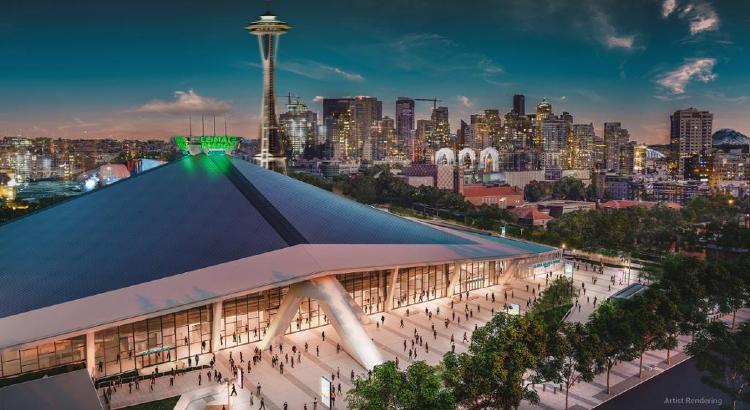Seattle’s new National Hockey League team doesn’t have a name yet, but its soon-to-be renovated arena already does.
The most unusual thing? It’s named after a meaningful cause rather than its corporate sponsor.
The NHL, the Oak View Group (which is re-developing the arena) and Amazon (the corporate sponsor) announced yesterday that the historic Seattle Center Arena will reopen next year as Climate Pledge Arena.
The name boosts Amazon’s participation in a nonprofit the internet commerce giant founded last fall that commits signing companies to attain net-zero carbon emissions by 2040. So far Amazon’s the only participating company.
But it also serves to promote the arena’s goal to attain International Living Future Institute’s Zero Carbon certification.
“This arena is really about climate and The Climate Pledge, not being named after a big corporation,” former ILFI Chair Jason F. McLennan, who’s a consultant on the project, said in a press release. “It is named after a vision to move to a responsible place for the planet.”
As part of the sponsorship deal with Amazon, Oak View Group committed to other sustainability features. Among them:
- The building will use only electricity (other hockey arenas use gas to help freeze their ice).
- On-site solar panels will generate much of the building’s power.
- Most concession food will be locally sourced; unused food will be donated to the needy.
- Visitors will have access only to recycling and composting bins — not trash cans — and single-use plastics will be prohibited.
- Even the ice-resurfacing vehicle will run on electricity.
Sponsors’ naming rights for sports venues often generate complaints, usually about commercialism. Criticism for Climate Pledge Arena came from a couple of other directions.
A You Tuber known at “The Hockey Guy” panned it for playing into stereotypes about Seattle. He’s worried about the hockey team’s eventual name: “I don’t want the Seattle Zero Carbons. I don’t want the Seattle Net Neutrals, the Seattle Green Energys. I don’t want solar panels on the backs of their jerseys.”
On the other hand, Gizmodo columnist Brian Kahn pointed to shortcomings in Amazon’s environmental record — some of which may be valid. He also characterized the arena’s sustainable features as “little things the arena will reportedly do right.”
That last point seems a bit off, though. It’s fair to call out large corporations for their environmental shortcomings. In Amazon’s case, the rap is that the company’s current delivery emissions and packaging waste dwarf promises about a carbon-free future.
But steps forward and doing the right ought to be celebrated. Zero Carbon is a year-old ILFI program that’s a bit less stringent than ILFI’s Zero Energy certification, in that it allows facilities to meet zero-carbon-emission partly by buying off-site energy. But Zero Carbon still goes much further than the commitments of other sports arenas. And it requires a yearlong performance audit, so it’s more difficult to game than other certification platforms.
Sure, one big part of this is public relations — even if some people find the name clunky. According to a 2017 by GMR Marketing, naming rights to an arena for one of the “big four” is valued at around $6.5 million a year. In other words, repeating the words “Carbon Pledge Arena” on national networks has real value. A bullhorn that big certain to acquaint a lot people with the nee for climate-change action and will legitimize it for many others.
Just consider the way that NHL Seattle CEO Tod Leiweke is talking about the commitment: “How can you not have a building that’s committed to the climate pledge,” he says on the above video.
Until recently, that’s the kind of thing that you’d only hear from those of us in the trenches of the movement for regenerative design and construction.
NHL Seattle, which owns the new hockey franchise, is closely tied to the Oak View Group, which in 2018 won a bid to redevelop and operate the city-owned arena. The 58-year-old building opened as the Washington State pavilion during Seattle’s 1962 world’s fair. It has since served mainly as a concert venue and basketball arena. But it had been considered outdated long before the NBA’s Supersonics left Seattle in 2008.
The $900 renovation project involved gutting almost everything but the building’s concrete skeleton and its iconic standing-seam, peaked roof. Designers are Populous, the Kansas City-born sports architecture giant. Project manager is Denver-based CAA ICON, and general contractor is MA Mortenson, which is based in Minneapolis.
PHOTO ABOVE: Courtesy Oak View Group.


